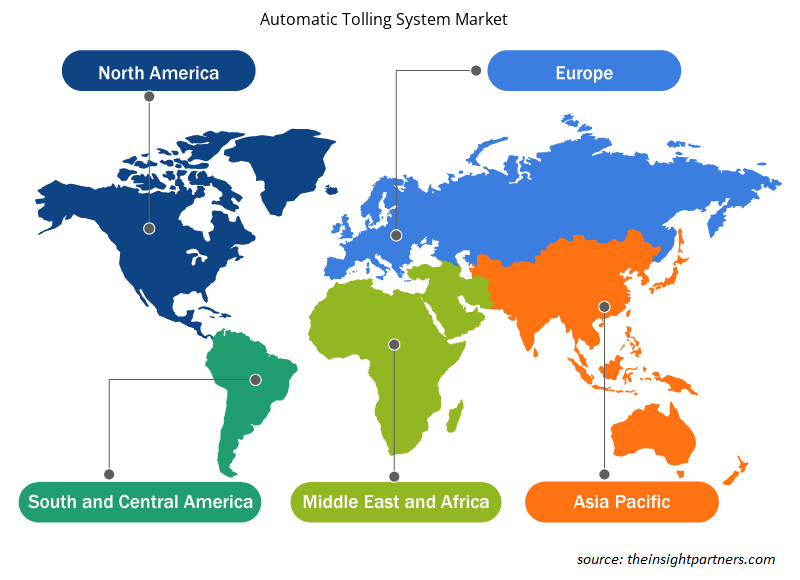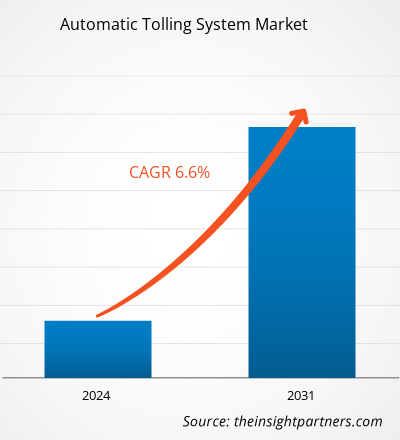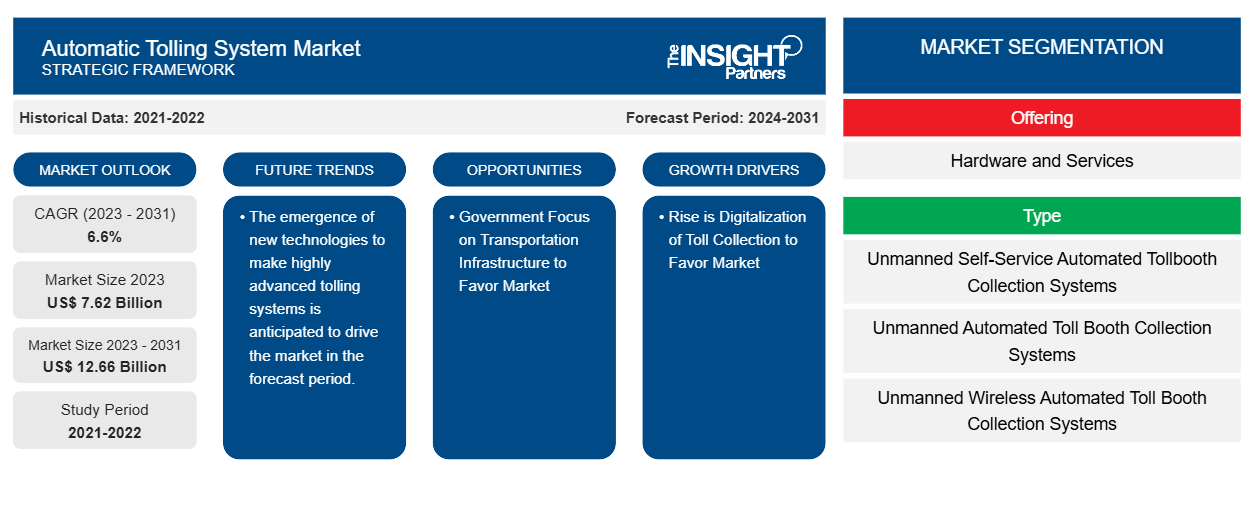من المتوقع أن يصل حجم سوق نظام تحصيل الرسوم الآلي إلى 12.66 مليار دولار أمريكي بحلول عام 2031 من 7.62 مليار دولار أمريكي في عام 2023. ومن المتوقع أن يسجل السوق معدل نمو سنوي مركب بنسبة 6.6٪ خلال الفترة 2023-2031. ومن المرجح أن يكون ارتفاع الرقمنة في تحصيل الرسوم والفوائد الاقتصادية والسلامة طويلة الأجل هي المحركات والاتجاهات الرئيسية للسوق.
تحليل سوق نظام تحصيل الرسوم الآلي
يشهد سوق أنظمة تحصيل الرسوم الآلية نموًا كبيرًا على مستوى العالم. ويعزى هذا النمو إلى عوامل مثل ارتفاع الرقمنة في تحصيل الرسوم والفوائد الاقتصادية والسلامة طويلة الأجل. وعلاوة على ذلك، من المتوقع أن يؤدي الطلب المتزايد على أنظمة إدارة الرسوم الفعالة في الاقتصادات الناشئة وظهور تقنيات جديدة لإنشاء أنظمة رسوم متقدمة للغاية إلى دفع السوق في السنوات القادمة.
نظرة عامة على سوق نظام تحصيل الرسوم الآلي
تفرض أنظمة تحصيل الرسوم إلكترونيًا رسومًا على المستخدمين دون الحاجة إلى أي إجراء أو توقف من جانب السائق. يقوم النظام بخصم الرسوم من حسابات أصحاب السيارات المسجلة أو تحديد لوحة الترخيص للفوترة لاحقًا دون الحاجة إلى توقف المركبات . تعمل مسارات تحصيل الرسوم إلكترونيًا على تحسين سرعة وكفاءة تدفق المرور وتوفير وقت السائق.
قم بتخصيص هذا التقرير ليناسب متطلباتك
ستحصل على تخصيص لأي تقرير - مجانًا - بما في ذلك أجزاء من هذا التقرير، أو تحليل على مستوى الدولة، وحزمة بيانات Excel، بالإضافة إلى الاستفادة من العروض والخصومات الرائعة للشركات الناشئة والجامعات
-
احصل على أهم اتجاهات السوق الرئيسية لهذا التقرير.ستتضمن هذه العينة المجانية تحليلاً للبيانات، بدءًا من اتجاهات السوق وحتى التقديرات والتوقعات.
محركات وفرص سوق نظام تحصيل الرسوم الآلي
الارتفاع هو رقمنة تحصيل الرسوم لصالح السوق
إن زيادة التحول الرقمي في تحصيل الرسوم يمكن أن يكون في الواقع محركًا لسوق أنظمة تحصيل الرسوم الآلية. فهي توفر كفاءة وراحة محسّنة، وتكاليف تشغيلية مخفضة، ودقة وأمانًا محسّنين، وتكاملًا سلسًا مع أنظمة أخرى، وجمع البيانات وتحليلها، وراحة المستخدم ورضاه، وزيادة المبادرات واللوائح الحكومية والفوائد البيئية. تعمل الرقمنة على تبسيط عملية تحصيل الرسوم، مما يقلل من متطلبات أنظمة الرسوم اليدوية ويسمح بالمعاملات بوتيرة سريعة. علاوة على ذلك، فإن العديد من أنظمة الرسوم الرقمية لديها طرق دفع مختلفة ، مثل الدفع عبر الهاتف المحمول والمحافظ الإلكترونية، مما يعزز راحة المستخدم.
الحكومة تركز على البنية التحتية للنقل لصالح السوق
إن تركيز الحكومة على البنية التحتية للنقل هو في الواقع محرك سوق تحصيل الرسوم الآلي على مستوى العالم. وفقًا لمكتب الإحصاء الأمريكي، زاد عدد سكان الولايات المتحدة بنسبة 0.4٪ في عام 2022 مقارنة بعام 2021. هناك ارتفاع في عدد السكان في أمريكا الشمالية، مما شجع الهيئات الحكومية على الاستثمار في بناء بنية تحتية فعالة للتعامل مع عدد السكان المتزايد واستدامة النمو الاقتصادي. إن التركيز المتزايد على إعادة بناء البنية التحتية القديمة وإدراج الحلول الذكية عامل رئيسي يغذي اعتماد أنظمة تحصيل الرسوم الآلية في المنطقة. وبالتالي، بالنظر إلى المعايير المذكورة أعلاه، فإن تركيز الحكومة على البنية التحتية للنقل يغذي سوق تحصيل الرسوم الآلية.
تقرير تحليل تجزئة سوق نظام تحصيل الرسوم الآلي
إن القطاعات الرئيسية التي ساهمت في اشتقاق تحليل سوق نظام تحصيل الرسوم التلقائي هي العرض والنوع.
- بناءً على العرض، يتم تقسيم سوق نظام تحصيل الرسوم التلقائي إلى الأجهزة والخدمات. ومن المتوقع أن يحظى قطاع الأجهزة بحصة سوقية كبيرة خلال فترة التوقعات.
- بناءً على النوع، يتم تقسيم سوق نظام تحصيل الرسوم التلقائي إلى أنظمة تحصيل رسوم ذاتية الخدمة بدون طيار، وأنظمة تحصيل رسوم آلية بدون طيار، وأنظمة تحصيل رسوم آلية لاسلكية بدون طيار. ومن المتوقع أن يستحوذ قطاع أنظمة تحصيل رسوم ذاتية الخدمة بدون طيار على حصة سوقية كبيرة في فترة التوقعات.
تحليل حصة سوق نظام تحصيل الرسوم الأوتوماتيكي حسب المنطقة الجغرافية
ينقسم النطاق الجغرافي لتقرير سوق نظام تحصيل الرسوم التلقائي بشكل أساسي إلى خمس مناطق: أمريكا الشمالية، وآسيا والمحيط الهادئ، وأوروبا، والشرق الأوسط وأفريقيا، وأمريكا الجنوبية والوسطى.
سيطرت أمريكا الشمالية على سوق نظام تحصيل الرسوم الآلي. وقد أدت اتجاهات تبني التكنولوجيا العالية في مختلف الصناعات في منطقة أمريكا الشمالية إلى تغذية نمو سوق نظام تحصيل الرسوم الآلي. ومن المتوقع أن تؤدي عوامل مثل زيادة اعتماد الأدوات الرقمية والإنفاق التكنولوجي العالي من قبل الوكالات الحكومية إلى دفع نمو سوق نظام تحصيل الرسوم الآلي في أمريكا الشمالية. وعلاوة على ذلك، فإن التركيز القوي على البحث والتطوير في الاقتصادات المتقدمة في الولايات المتحدة وكندا يجبر اللاعبين في أمريكا الشمالية على جلب حلول متقدمة تقنيًا إلى السوق. بالإضافة إلى ذلك، يوجد في الولايات المتحدة عدد كبير من اللاعبين في سوق نظام تحصيل الرسوم الآلي الذين يركزون بشكل متزايد على تطوير حلول مبتكرة. تساهم كل هذه العوامل في نمو سوق نظام تحصيل الرسوم الآلي في المنطقة.
رؤى إقليمية حول سوق نظام تحصيل الرسوم الآلي
لقد قام المحللون في Insight Partners بشرح الاتجاهات والعوامل الإقليمية المؤثرة على سوق نظام تحصيل الرسوم الآلي طوال فترة التوقعات بشكل شامل. يناقش هذا القسم أيضًا قطاعات سوق نظام تحصيل الرسوم الآلي والجغرافيا في جميع أنحاء أمريكا الشمالية وأوروبا ومنطقة آسيا والمحيط الهادئ والشرق الأوسط وأفريقيا وأمريكا الجنوبية والوسطى.

- احصل على البيانات الإقليمية المحددة لسوق نظام تحصيل الرسوم التلقائي
نطاق تقرير سوق نظام تحصيل الرسوم الآلي
| سمة التقرير | تفاصيل |
|---|---|
| حجم السوق في عام 2023 | 7.62 مليار دولار أمريكي |
| حجم السوق بحلول عام 2031 | 12.66 مليار دولار أمريكي |
| معدل النمو السنوي المركب العالمي (2023 - 2031) | 6.6% |
| البيانات التاريخية | 2021-2022 |
| فترة التنبؤ | 2024-2031 |
| القطاعات المغطاة |
عن طريق العرض
|
| المناطق والدول المغطاة |
أمريكا الشمالية
|
| قادة السوق وملفات تعريف الشركات الرئيسية |
|
كثافة اللاعبين في سوق نظام تحصيل الرسوم الآلي: فهم تأثيره على ديناميكيات الأعمال
يشهد سوق أنظمة تحصيل الرسوم الآلية نموًا سريعًا، مدفوعًا بالطلب المتزايد من المستخدم النهائي بسبب عوامل مثل تفضيلات المستهلكين المتطورة والتقدم التكنولوجي والوعي المتزايد بفوائد المنتج. ومع ارتفاع الطلب، تعمل الشركات على توسيع عروضها والابتكار لتلبية احتياجات المستهلكين والاستفادة من الاتجاهات الناشئة، مما يؤدي إلى زيادة نمو السوق.
تشير كثافة اللاعبين في السوق إلى توزيع الشركات أو المؤسسات العاملة في سوق أو صناعة معينة. وهي تشير إلى عدد المنافسين (اللاعبين في السوق) الموجودين في مساحة سوق معينة نسبة إلى حجمها أو قيمتها السوقية الإجمالية.
الشركات الرئيسية العاملة في سوق نظام تحصيل الرسوم الأوتوماتيكي هي:
- خدمات الأعمال التجارية ذات المسؤولية المحدودة
- شركة إيفكون المحدودة
- فيج الكترونيك
- شركة ميتسوبيشي لأنظمة الآلات الثقيلة المحدودة
- نيولوجي، المحدودة
- شركة رايثيون تكنولوجيز
إخلاء المسؤولية : الشركات المذكورة أعلاه ليست مرتبة بأي ترتيب معين.

- احصل على نظرة عامة على أهم اللاعبين الرئيسيين في سوق نظام تحصيل الرسوم التلقائي
أخبار سوق نظام تحصيل الرسوم الآلي والتطورات الأخيرة
يتم تقييم سوق نظام تحصيل الرسوم الآلي من خلال جمع البيانات النوعية والكمية بعد البحث الأولي والثانوي، والتي تتضمن منشورات الشركات المهمة وبيانات الجمعيات وقواعد البيانات. فيما يلي بعض التطورات في سوق نظام تحصيل الرسوم الآلي:
- تعتزم الهند إطلاق نظام تحصيل رسوم المرور عبر نظام تحديد المواقع العالمي (GPS) قريبًا. وأعلنت وزارة الاتحاد أن أنظمة تحصيل الرسوم عبر نظام تحديد المواقع العالمي (GPS) ستحل محل ساحات تحصيل الرسوم على الطرق السريعة الحالية في البلاد. وأعلن وزير الطرق والنقل والطرق السريعة أن عملية التحول ستتم في وقت مبكر من أبريل/نيسان من هذا العام. (موقع شركة HT Auto على الإنترنت، يونيو/حزيران 2024)
تقرير سوق نظام تحصيل الرسوم الآلي والتغطية والنتائج المتوقعة
يوفر تقرير "حجم سوق نظام تحصيل الرسوم التلقائي والتوقعات (2021-2031)" تحليلاً مفصلاً للسوق يغطي المجالات التالية:
- حجم سوق نظام تحصيل الرسوم التلقائي والتوقعات على المستويات العالمية والإقليمية والوطنية لجميع قطاعات السوق الرئيسية التي يغطيها النطاق
- اتجاهات سوق نظام تحصيل الرسوم الآلي بالإضافة إلى ديناميكيات السوق مثل السائقين والقيود والفرص الرئيسية
- تحليل مفصل لقوى PEST/Porter الخمس وSWOT
- تحليل سوق نظام تحصيل الرسوم الآلي الذي يغطي اتجاهات السوق الرئيسية والإطار العالمي والإقليمي والجهات الفاعلة الرئيسية واللوائح والتطورات الأخيرة في السوق
- تحليل المشهد الصناعي والمنافسة الذي يغطي تركيز السوق، وتحليل خريطة الحرارة، واللاعبين البارزين، والتطورات الأخيرة لسوق نظام تحصيل الرسوم التلقائي
- ملفات تعريف الشركة التفصيلية
- التحليل التاريخي (سنتان)، سنة الأساس، التوقعات (7 سنوات) مع معدل النمو السنوي المركب
- تحليل PEST و SWOT
- حجم السوق والقيمة / الحجم - عالمي، إقليمي، بلد
- الصناعة والمنافسة
- مجموعة بيانات إكسل
التقارير الحديثة
شهادات العملاء
سبب الشراء
- اتخاذ قرارات مدروسة
- فهم ديناميكيات السوق
- تحليل المنافسة
- رؤى العملاء
- توقعات السوق
- تخفيف المخاطر
- التخطيط الاستراتيجي
- مبررات الاستثمار
- تحديد الأسواق الناشئة
- تحسين استراتيجيات التسويق
- تعزيز الكفاءة التشغيلية
- مواكبة التوجهات التنظيمية























 احصل على عينة مجانية ل - سوق نظام تحصيل الرسوم التلقائي
احصل على عينة مجانية ل - سوق نظام تحصيل الرسوم التلقائي